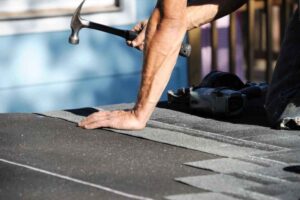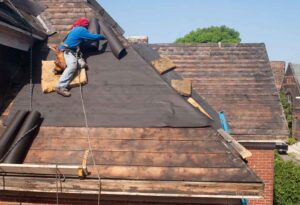At Shull Roofing, we often get asked about synthetic tile roofs and how they’re manufactured. Let’s learn about this fascinating process and uncover the benefits these innovative roofing materials provide.
What Are Synthetic Tile Roofs?
Synthetic tile roofs are modern alternatives to traditional roofing materials. They mimic the look of natural materials like slate, clay, or wood but have several advantages. These roofs are lightweight, durable, and often more cost-effective than their natural counterparts.
The Manufacturing Process
Raw Materials: The Building Blocks
The journey of synthetic tile roofs begins with the raw materials. These tiles are typically made from a mix of plastic and rubber compounds. The exact composition varies depending on the manufacturer and the specific type of synthetic tile roof being produced. Common materials include recycled plastics, virgin plastics, rubber compounds, and mineral fillers.
Mixing and Molding: From Liquid to Solid
The raw materials are carefully measured and mixed to create a uniform compound. This mixture is then heated and melted in large industrial ovens. Once the material reaches the right temperature, it’s poured into molds. These molds come in various shapes and sizes, allowing manufacturers to create different types of synthetic tile roofs. Some common styles include slate-look tiles, clay tile replicas, and wood shake imitations.
Cooling and Finishing: The Final Touches
After molding, the tiles are cooled and cured. This step is crucial as it helps the tiles retain their shape and develop their strength. To make synthetic tile roofs look like their natural counterparts, manufacturers add color and texture. This is typically done through either in-mold coloration or surface application, allowing for a wide range of colors and finishes to match almost any architectural style.
Types of Synthetic Tile Roofs
There are several types of synthetic tile roofs available in the market. Each type is designed to mimic a specific natural material:
Synthetic Slate Tiles
These tiles replicate the look of natural slate. They’re lighter and more affordable than real slate, making them a popular choice for homeowners who love the slate aesthetic but want a more budget-friendly option.
Synthetic Clay Tiles
Designed to look like traditional clay tiles, these synthetic versions offer the same Mediterranean charm without the weight and fragility of real clay.
Synthetic Wood Shakes
For those who love the rustic look of wood shakes but worry about fire resistance and maintenance, synthetic wood shakes provide an excellent alternative.
What Are Synthetic Tile Roofs Made Of?
As mentioned earlier, synthetic tile roofs are primarily made of plastic and rubber compounds. However, the exact composition can vary. Here’s a more detailed look at what synthetic tile roofs are made of:
Polyethylene: This plastic is often used as the base material due to its durability and weather resistance.
Rubber Compounds: These add flexibility and impact resistance to the tiles.
UV Inhibitors: These additives help protect the tiles from sun damage and color fading.
Mineral Fillers: Materials like limestone or clay are often added to improve the tiles’ fire resistance and overall durability.
Pigments: These give the tiles their color and help them mimic natural materials more closely.
The Benefits of Choosing Synthetic Tile Roofs
Synthetic tile roofs offer numerous advantages:
Durability: They can withstand extreme weather conditions and often have extended warranties.
Lightweight: They put less stress on your home’s structure compared to natural materials.
Low Maintenance: These roofs require minimal upkeep, saving you time and money in the long run.
Eco-friendly: Many synthetic tiles are made from recycled materials and are recyclable at the end of their lifespan.
Versatility: With various styles and colors available, you can find a synthetic tile to match any architectural design.
Shull Roofing’s Final Word
The manufacturing process of synthetic tile roofs is a blend of advanced technology and careful craftsmanship. From the initial mixing of raw materials to the final application of colors and textures, each step is crucial in creating a product that’s both beautiful and functional.
At Shull Roofing, we’re excited about the possibilities that synthetic tile roofs offer homeowners. Whether you’re considering a roof replacement or building a new home, synthetic tile roofs are certainly worth considering.
The key to a great roof isn’t just in the materials—it’s also in the installation. Contact us today for a free estimate to guarantee that your synthetic tile roof is installed correctly.




